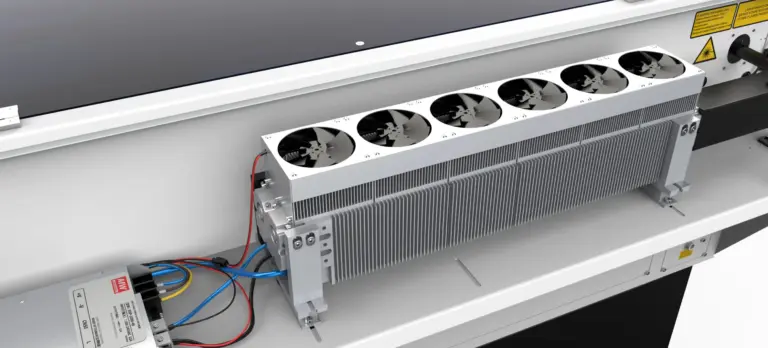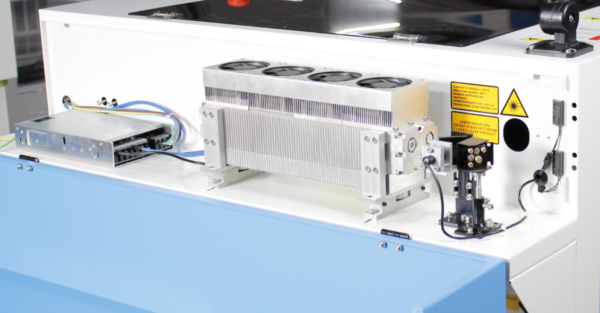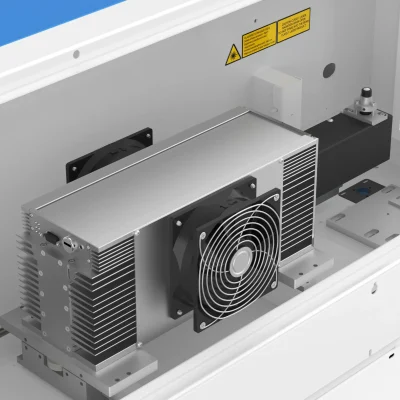Contents
An RF laser tube is the heart of many high-precision cutting, engraving, and marking systems. Its performance and reliability directly determine production quality and efficiency.
This article takes a closer look at what really defines the lifespan of an RF laser tube, the factors that shorten or extend it, and—most importantly—methods you can apply to maximize operating life. Whether you are using a Coherent, SPT, Iradion, or another brand, adopting the right maintenance and operational strategies can help you achieve consistent performance while lowering long-term costs.
1. Understanding RF Laser Tube Lifespan
A common misconception is that the lifespan of an RF laser tube is measured from the date it was manufactured or installed. However, only the total hours the tube has been actively operating count. If a machine has been sitting idle for two years but the laser has only been used for fifty hours, then the tube has accumulated just fifty hours of life.
It is important to recognize that RF laser tube lifespan is not a fixed countdown but a statistical measure. It represents the average number of hours a tube can continue to deliver the required performance before its output falls below production specifications, even with proper maintenance. End-of-life usually manifests as a gradual reduction in output power or beam quality rather than a sudden failure. Over time, the internal electrodes, RF circuitry, and sealed CO₂ mixture naturally degrade until the tube can no longer maintain consistent performance.
Rated lifespan, as provided by manufacturers, is determined through controlled testing under stable conditions of temperature, cooling, duty cycle, and power level. Premium RF tubes from leading brands, such as Coherent, SPT, and Iradion, are rated for up to 45,000 hours under these laboratory settings. These figures should be seen as benchmarks rather than guarantees, because real-world conditions rarely mirror the ideal test environment. Factors such as ambient temperature, humidity, electrical stability, and production workload can either shorten or extend the actual service life.
For users, the most practical way to track the lifespan of an RF tube is simply to sum the total number of hours it has been in operation. Each hour of use counts fully, regardless of whether the tube is running at full power or a reduced setting. Though operating at lower power can reduce thermal stress and slow the rate of degradation, it does not alter the accumulation of hours. This approach gives a clear, hands-on measure of the tube’s actual life.

2. Factors That Impact RF Laser Tube Lifespan
The lifespan of an RF laser tube is influenced by multiple factors, both internal and external.
2.1 Operating Temperature
The temperature at which an RF laser tube operates has a direct effect on its longevity. Elevated temperatures increase thermal stress on the tube’s internal components, including electrodes, RF circuitry, and the sealed CO₂ mixture. Even slight deviations from optimal temperature ranges can accelerate internal wear, leading to a gradual decline in beam quality and output power over time.
2.2 Cooling Method and Efficiency
How effectively the tube dissipates heat plays a critical role in its lifespan. Water cooling and air cooling systems differ in their thermal response, and insufficient heat removal can create localized hotspots. These hotspots concentrate stress on specific components, intensifying internal wear and contributing to uneven degradation, which accelerates the reduction of consistent output.

2.3 Duty Cycle and Workload
The duty cycle—the proportion of time an RF laser tube is actively operating—strongly affects its lifespan. Every start and stop causes rapid heating and cooling, creating repeated stress on internal components. Frequent cycling speeds up electrode wear, strains seals and glass interfaces, and gradually degrades the gas mixture, reducing overall stability and output.
The impact of cycling can be greater than total operating hours alone. For example, 1,000 hours of continuous operation mostly stresses the tube uniformly, while the same 1,000 hours split into thousands of short cycles impose far more stress, accelerating degradation. Tubes may see their effective lifespan shortened when subjected to frequent start-stop conditions, even if total runtime is identical.
2.4 Power Supply and Power Settings
RF laser tubes are highly sensitive to voltage fluctuations and electrical noise from poor power sources. Even minor instabilities can trigger micro-arcing inside the tube, which accelerates electrode wear and gradually undermines performance consistency. Beyond supply stability, the level of power delivered per pulse also plays a critical role. Operating at higher power increases thermal and electrical stress on the electrodes and RF circuitry, speeding up internal wear, while lower power reduces immediate stress but still contributes to cumulative aging over time.
2.5 Environmental Conditions
The longevity of an RF laser tube is influenced by both external conditions and natural wear. High humidity can corrode electrodes, while dust and airborne particles may disrupt uniform electrical discharge, impair cooling, or reduce optical performance. Mechanical vibrations and extreme temperature fluctuations further strain the tube’s internal structures, and factors such as chemical pollutants, sudden atmospheric changes, or electromagnetic interference can subtly affect operation.
Even under ideal conditions, RF laser tubes naturally degrade over time. Components like electrodes, RF circuitry, and the sealed CO₂ mixture gradually wear, making performance decline inevitable. By understanding both environmental influences and the inherent aging process, users can better anticipate service life and maintain consistent output throughout the tube’s operational period.

3. How to Extend the Lifespan of an RF Laser Tube?
Nothing lasts forever, but with proper maintenance, an RF laser tube can deliver reliable performance for far longer than its baseline rating.
3.1 Maintain Effective Thermal Management
Since the actual output power of the RF laser tube only accounts for about 10% to 20% of the RF power generated by the internal RF amplifier, the other power is basically converted into heat. If this heat is not effectively managed, it can accumulate within the tube, causing the operating temperature to exceed the recommended range of 5°C to 45°C (41–113°F). Excessive heat can degrade beam quality and reduce the lifespan of RF laser tube. To maintain stable temperatures, the RF laser tubes are equipped with either air or water cooling systems, depending on the power and design of the model.
Learn more about Power Conversion Efficiency of RF CO₂ Lasers.
Maintenance differs depending on the cooling method:
● Air-Cooling Systems
Air-cooled systems are commonly used in lower-power RF laser tubes. To ensure optimal performance, it’s better to:
- ○ Regularly clean air filters and fans to prevent dust buildup, which can obstruct airflow and create hotspots.
- ○ Ensure proper ventilation around the machine to allow consistent heat dissipation.
- ○ Inspect the heat sinks or condensers for dust or debris, cleaning them as needed to maintain efficient cooling.
● Water-Cooling Systems
Water-cooled systems are employed in higher-power RF laser tubes for more efficient heat dissipation. Maintenance steps include:
- ○ Use distilled water with an appropriate antifreeze solution to prevent mineral deposits and corrosion.
- ○ Check coolant levels frequently and refill to maintain proper circulation.
- ○ Drain, clean, and replace coolant periodically (typically every 2–3 months) to avoid stagnation and bacterial growth.
- ○ Purge the system of air bubbles, which can reduce cooling efficiency and lead to localized overheating.
And the external cooling system of RF laser should meet these requirements, as SPT recommended:
- Flow rate of cooling water at the laser’s outlet (minimum): 5.7L/min
- Cooling water temperature range: 10-35 ℃
- Intake pressure (laser inlet): 205-520 kPa
- Hardness of cooling water (equivalent to CaCO3): <250mg/L
- Pressure difference: >170kPa
- Carrier heat: 2.5kW PH value: 5-9
- Particle size: less than 200 microns in diameter
More steps, click here.
3.2 Optimize Duty Cycle and Workload
Each start and stop of the tube causes rapid heating and cooling, placing stress on electrodes, seals, and the gas mixture. Therefore, minimizing unnecessary cycling helps reduce cumulative wear. Remember to:
○ Batch tasks into longer, uninterrupted runs whenever possible.
○ Adhere to the manufacturer’s recommended duty cycle for your tube and power level.
○ Minimize frequent on/off switching and avoid short, repeated jobs.
○ Schedule operations efficiently to maintain consistent laser-on periods without unnecessary cycling.
3.3 Power Supply and Power Settings
RF laser tubes require a consistent and stable electrical supply within specified voltage and current ranges. Power fluctuations or operation outside recommended settings can stress internal components. Because the rated voltage and current vary between manufacturers, you should always refer to the specific guidelines provided for your tube. These guidelines detail the recommended operating voltage, maximum output, and duty cycle limits, which should be followed closely to ensure safe and reliable operation.
It‘s recommended to:
○ Use a high-quality RF power supply equipped with surge protection.
○ Ensure the electrical source is stable and free of noise.
○ Operate within the manufacturer-specified power range for your tube.
○ Avoid exceeding the maximum output for extended periods.
○ Adjust power settings according to job requirements, keeping them within recommended limits.
3.4 Maintain an Optimal Environment
RF laser tubes perform best in a clean, dry, and stable environment. To support this:
○ Keep the workspace free from dust and airborne particles.
○ Control humidity(≤95%) and minimize exposure to chemical pollutants.
○ Avoid strong vibrations, shocks, or mechanical disturbances.
○ Maintain consistent temperature and humidity, avoiding extreme fluctuations.
3.5 Maintain Optical Path Integrity
A well-maintained optical system prevents unnecessary stress on the RF laser tube and ensures stable output. Regular tasks should include:
○ Inspect mirrors, lenses, and windows for dust, residue, or alignment shifts.
○ Clean optical components with appropriate tools and solvents recommended by the manufacturer.
○ Verify beam alignment periodically, as misalignment increases reflection losses and internal strain on the tube.
○ Replace worn or damaged optics promptly to avoid performance degradation.
3.6 Regular Monitoring and Maintenance
Consistent monitoring and maintenance help track tube performance and ensure reliable operation. Key practices include:
○ Use a power meter or energy meter to regularly check laser output.
○ Clean optical components periodically to prevent buildup or contamination.
○ Record cumulative operating hours to evaluate RF laser tube lifespan progression and plan maintenance schedules.
Conclusion
RF laser tubes are durable, but they are not immune to wear. While internal aging is inevitable, careful attention to cooling, duty cycle, power supply, environment, and optical integrity can significantly extend the lifespan of an RF laser source.
Learn more: Why Choose an RF Laser Source? Key Advantages Explained
FAQs
How can I tell if my RF laser tube is nearing the end of its life?
The most common signs are gradual power loss, unstable beam quality, or difficulty maintaining consistent output at normal settings. Regular monitoring with a power meter helps detect early decline.
How often should an RF laser tube be maintained?
Routine checks should be performed weekly, such as cleaning air filters or inspecting the cooling system. Optical components usually need monthly inspection and cleaning, while coolant in water-cooled systems should be replaced every 2–3 months. Comprehensive maintenance—covering output monitoring, alignment, and system cleaning—is typically recommended every 6–12 months, depending on usage intensity.
How should I maintain an RF laser tube during winter?
The most important considerations in winter are temperature and humidity. Keep the operating environment above 5 °C (41 °F) to prevent freezing and condensation, and avoid rapid temperature fluctuations when starting the machine. At the same time, ensure humidity remains below 95% to prevent moisture from condensing inside the tube or on optical components. If using water cooling, add the manufacturer-recommended antifreeze and keep the system circulating to maintain stable conditions.


.png) International
International
 United States
United States
 Brasil
Brasil
 Canada
Canada
 Costa Rica
Costa Rica
 Mexico
Mexico
 Česká
Česká
 Romania
Romania
 Polska
Polska
 Ireland
Ireland
 Portugal
Portugal
 Lietuva
Lietuva
 Россия
Россия Deutschland
Deutschland
 Britain
Britain
 Україна
Україна
 France
France
 Sverige
Sverige
 Italia
Italia
 Norway
Norway
 Denmark
Denmark
 Ελλάδα
Ελλάδα
 한국
한국
 中国
中国
 ประเทศไทย
ประเทศไทย
 中国香港
中国香港
 Israel
Israel
 中國臺灣
中國臺灣
 India
India
 پاکستان
پاکستان
 پශ්රී ලංකා
پශ්රී ලංකා
 ジャパン
ジャパン
 Australia
Australia
 New Zealand
New Zealand
 South Africa
South Africa